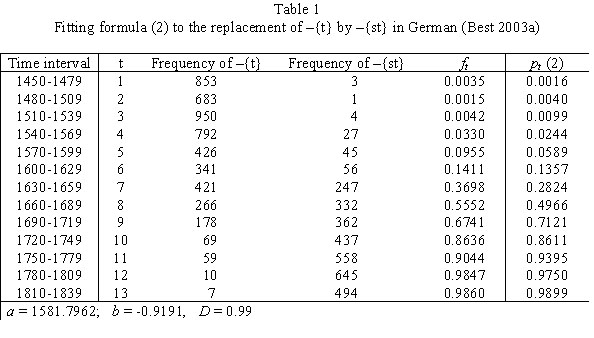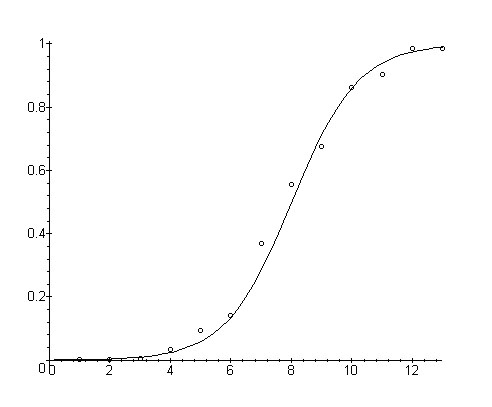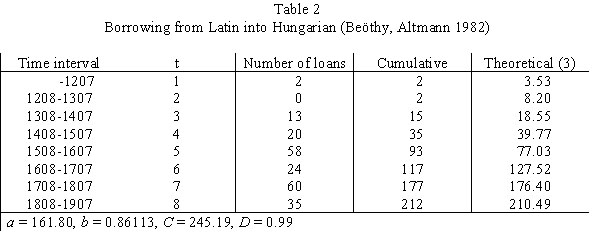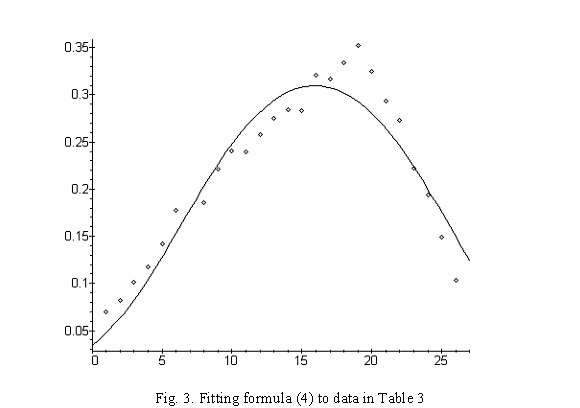Difference between revisions of "Change in language"
| Line 124: | Line 124: | ||
'''Best, K.-H.''' (2002). Satzlängen im Deutschen: Verteilungen, Mittelwerte, Sprachwandel. ''Göttinger Beiträge zur Sprachwissenschaft 7, 7-31.'' | '''Best, K.-H.''' (2002). Satzlängen im Deutschen: Verteilungen, Mittelwerte, Sprachwandel. ''Göttinger Beiträge zur Sprachwissenschaft 7, 7-31.'' | ||
| − | '''Best, K.H.''' (2003a). | + | '''Best, K.H.''' (2003a). “Spracherwerb, Sprachwandel und Wortschatzwachstum in Texten. Zur Reichweite des Piotrowski-Gesetzes.” ''Glottometrics 6, 9-34.'' |
'''Best, K.-H.''' (2003b). Wie verläuft Sprachwandel? ''Naukovij Visnik Černivec´kogo Univeristetu 155, 86-94.'' | '''Best, K.-H.''' (2003b). Wie verläuft Sprachwandel? ''Naukovij Visnik Černivec´kogo Univeristetu 155, 86-94.'' | ||
Revision as of 09:19, 28 March 2006
1. Problem and history
Everything in language changes. The complete complex of causes can not be ascertained; we are interested in the general processes of change and its course, whatever the entity con¬cerned. There are four aspects treated in this volume, for which models could be set up:
Qualitative change
(i) change of individual entities, which is the object of this chapter
(ii) sound change ( )
)
Volume change
(iii) lexicon growth ( )
)
(iv) lexicon decay or glottochronology ( )
)
The research in quantitative form most probably began with different hypotheses of G. K. Zipf concerning age and frequency, age and length, etc. (1946, 1947, 1949, cf. Prün 1985). Measurement concerning individual phenomena can be found in Piotrowski (1960), Graudina (1964), Lazard (1965), whose results have been empirically fitted by Piotrovskaja, Piotrowski (1974) using an arctangent function. The theoretical derivation has been performed by Beö¬thy, Altmann (1982), Altmann, von Buttlar, Rott, Strauß (1983) combining Piotrowski´s find¬ings with an assumption of Weinreich, Labov, Herzog (1968). Altmann (1983) derived the three possible variants of the law shown below. A number of corroborations was brought by Best (1983), Best, Kohlhase (1983, 1983a), Imsiepen (1983), Kohlhase (1983), Müller-Hase¬mann (1983), Best, Altmann (1986), Kroch (1989a,b, 2001), Best, Beöthy, Altmann (1990), Tuldava (1998), Best (2001), Bresnan, Dingare, Manning (2001), Vulanović (2003). The law is called Piotrowski law or Piotrowski-Altmann law and is used for modelling phenomena like the increase of the number of borrowings, changes in morphology, etc.
2. Hypothesis
Everything in language changes as a result of interaction between old forms and new forms.
The independent variable is time, given usually in form of a transformed time index. The dependent variable is the proportion of new forms.
3. Derivation
The interaction can be presented in the form
(1)  ,
,
 = proportion of new forms
= proportion of new forms
 = a function of time (can also be a constant)
= a function of time (can also be a constant)
C = limit of change
t > 0, time
 = change of the proportion
= change of the proportion
telling that the change of the proportion of new forms is proportional to the interaction of new and old forms. The solution yields three variants:
(a) Complete change if C = 1 and  is constant
is constant
(2) 
where a is the integration constant. The result in (2) represents the so-called logistic curve used in different disciplines for modeling growth phenomena.
Example. Since years represent large numbers hindering the fitting, one usually transforms the time intervals in a time variable beginning with t = 1. Often the cumulative frequencies are changed to cumulative proportions, or the proportions are ascertained from the occurrence of rival forms. Complete change: The replacement of –{t} by –{st} in German 2nd person singular indicative present time with the verb “wollen”, shown by Best (2003a). The result of fitting is presented in Table 1 and Fig. 1. Here ft is the relative frequency of –{st}, pt is the computed relative frequency according to (2).
The fitting is excellent. The curve was fitted to the proportion of –{st} found in the sources.
(b) Partial change if  is constant, C is the asymptote
is constant, C is the asymptote
(3) 
and a is the integration constant.
Example. Partial change: Borrowings from Latin in Hungarian Beöthy and Altmann examined the borrowing from different langugages in Hungarian. The fate of Latin words is shown in Table 2 and Fig. 2. The fitting was performed for the cumulative values.
(c) Reversible change if  = a´ - b´t, C = constant
= a´ - b´t, C = constant
(4)
where a, b, c are simple functions of a´, b´and C.
Example 3. Reversible change: Epithesis with strong verbs in German. Imsiepen (1983) observed that the epithesis of /e/ with strong verbs (1st and 3rd person sg. Past tense) is a reversible process in German. Altmann (1983) has shown some estimation procedures for this curve, but since several observed values are very unreliable, Best, Beöthy and Altmann (1990) considered smoothed values (moving average of 7 values) and obtained the data in Table 3. They took the value of C into consideration and used formula (4).
The fitting is very good.
4. Author: G. Altmann
5. References
Altmann, G. (1983a). Das Piotrowski-Gesetz und seine Verallgemeinerungen. In: Best, K.-H., Kohlhase, J. (Hrsg.), Exakte Sprachwandelforschung: 54-90. Göttingen: Herodot.
Altmann, G. (1985). On the Dynamic Approach to Language. In: Ballmer, T. T. (ed.), Linguistic Dynamics: 181-189. Berlin/ New York: de Gruyter.
Altmann, G. (1992). Piotrowski’s Law of Language Change. In: Saukkonen, P. (ed.), What is Language Synergetics? 34-35. Oulu: Acta Universitatis Ouluensis, Series B: Humaniora, 16.
Altmann, G., Bagheri, D., Goebl, H., Köhler, R., Prün, C. (2002). Einführung in die quantitative Lexikologie. Götingen: Peust & Gutschmidt.
Altmann, G., v. Buttlar, H., Rott, W., Strauß, U. (1983). A law of change in language. In: Brainerd, B. (ed.), Historical linguistics: 104-115. Bochum: Brockmeyer.
Bailey, Ch.J.N. (1973). Variation and linguistic theory. Arlington: Center for Applied Lin-guistics.
Beöthy, E., Altmann, G. (1982). Das Piotrowski-Gesetz und der Lehnwort¬schatz. Zs. für Sprachwissenschaft 1, 171-178.
Best, K.-H. (1983). Zum morphologischen Wandel einiger deutscher Verben. In: Best, Kohlhase (eds.) 1983: 107-118.
Best, K.-H. (2000). Der Zuwachs der Wörter auf -ical im Deutschen. Glottometrics 2, 11-16.
Best, K.-H. (2001). Ein Beitrag zur Fremdwortdiskussion. In: Schierholz, S.J., Fobbe, E., Goes, S., Knirsch, R. (eds.), Die deutsche Sprache der Gegenwart. Festschrift für Dieter Cherubim zum 60. Geburtstag: 263-270. Frankfurt: Lang.
Best, K.-H. (2002). Satzlängen im Deutschen: Verteilungen, Mittelwerte, Sprachwandel. Göttinger Beiträge zur Sprachwissenschaft 7, 7-31.
Best, K.H. (2003a). “Spracherwerb, Sprachwandel und Wortschatzwachstum in Texten. Zur Reichweite des Piotrowski-Gesetzes.” Glottometrics 6, 9-34.
Best, K.-H. (2003b). Wie verläuft Sprachwandel? Naukovij Visnik Černivec´kogo Univeristetu 155, 86-94.
Best, K.-H. (2003c). “Spracherwerb, Sprachwandel und Wortschatzwachstum in Texten. Zur Reichweite des Piotrowski-Gesetzes.” Glottometrics 6, 9-34.
Best, K.-H. (2003d). Zum Wandel von Idiolekten. Naukovyj Visnyk Černivec’koho Universytetu, Vypusk 165-166, 36-43.
Best, K.-H. (2004). Kürzungstendenzen im Deutschen aus der Sicht der Quantitativen Linguistik. In: Bär, J. A., Roelcke, T., & Steinhauer, A. (Hrsg.), Sprachliche Kürze. Konzeptuelle, strukturelle und pragmatische Aspekte. Berlin/ New York: de Gruyter. (Im Druck)
Best, K.-H., Altmann, G. (1986). Untersuchungen zur Gesetzmäßigkeit von Entlehnungs¬prozessen im Deutschen. Folia Linguistica Historica 31-41.
Best, K.-H., Beöthy, E., Altmann, G. (1990). Ein methodischer Beitrag zum Piotrowski-Gesetz. Glottometrika 12, 115-124.
Best, K.H., Kohlhase, J. (eds.) (1983). Exakte Sprachwandelforschung. Göttingen, Herodot.
Best, K.-H., Kohlhase, J. (1983a). Der Wandel von ward zu wurde. In: Best, Kohlhase (eds.) 1983: 91-102.
Brainerd, B. (1983). A stochastic model for language change. In: Brainerd, B. (ed.): Historical linguistics: 25-49. Bochum: Brockmeyer.
Brainerd, B. (ed.) (1983). Historical linguistics. Bochum : Brockmeyer.
Bresnan, J., Dingare, S., Manning, C.D. (2001). Soft constraints mirror hard constraints: voice and person in English and Lummi. In: Butt, M., King, T.H. (eds.), Proceedings of the LFG01 Conference: 13-22. Stanford: CSLI (http://cslipublications.stanford.edu/LFG/6(lfg01.pdf)
Busch, A. (2002). Zur Entwicklung der Satzlängen in deutscher Fachsprache. Staatsexamensarbeit, Göttingen.
Graudina, L.V. (1964). Razvitie nulevoj formy roditel´nogo množestvennogo u suščestvitel´nych – edinic izmerenija. In: Razvitie grammatiki i leksiki sovremennogo russkogo jazyka: 210-221. Moskva: Nauka.
Greimas, A.J. (1966). Les aspects quantitatifs en linguistique diachronique. In: Statistique et analyse linguistique. Colloque de Strasbourg 20-22 avril 1964: 113-120. Paris.
Imsiepen, U. (1983). Die e-Epithese bei starken Verben im Deutschen. In: Best, Kohlhase (eds.) 1983: 119-114.
Klein, S. (1964). Dynamic simulation of historical change in language using Monte Carlo techniques. Santa Monica: System Development Corporation.
Klein, S. (1965). Some components of a program for dynamic modelling of historical change in language. In: [1.] International Conference on Computational Linguistics. New York, 19.-21.5.1965.
Kohlhase, J. (1983). Die Entwicklung von ward zu wurde beim Nürnberger Chronisten Heinrich Deichsler. In: Best, Kohlhase (eds.) 1983: 103-106.
Körner, H. (2001). Der Zuwachs der Wörter auf -ion im Deutschen. Glottometrics 2, 82-86.
Körner, H. (2003). Wortschatzentwicklung im Deutschen. Untersuchung zur Überprüfung des Piotrowski-Gesetzes. Magisterarbeit, Göttingen.
Körner, H. (2004). Zur Entwicklung des deutschen (Lehn)Wortschatzes. Glottometrics 7, 25-49.
Kroch, A.S. (1989a). Function and grammar in the history of English: periphrastic do. In: Fasold, R.W., Schiffrin, D. (eds.), Language change and variation: 133-172. Amsterdam: Benjamins.
Kroch, A.S. (1989b). Reflexes of grammar in patterns of language change. In: Fasold, R.W., Schiffrin, D. (eds.), Language change and variation: 199-244. Amsterdam: Benjamins.
Kroch, A.S. (2001). Syntactic change. In: Baltin, M, Collins, C. (eds.), The handbook of contemporary syntactic theory: 699-729. Oxford: Blackwell.
Lazard, G. (1965). Les empruntes arabes dans la prose persane du X-e au XII-e siècle : aperçu statistique. Revue de l´Ecole National des language orientales 2, 53-67.
Leopold, E. (1998). Stochastische Modellierung lexikalischer Evolutionsprozesse. Hamburg: Kovač.
Leopold, E. (2005). Das Piotrowski-Gesetz. In: Altmann, G., Köhler, R., Piotrowski, R. (Hg.), Quantitative Linguistik – Quantitative Linguistics. Ein internationales Handbuch: 627-633. Berlin/ N.Y.: de Gruyter.
Müller-Hasemann, W. (1983). Das Eindringen englischer Wörter ins Deutsche ab 1945. In: Best, Kohlhase (eds.) 1983: 143-160.
Ogura, M. (1993). The development of periphrastic do in Enbglish: A case of lexical diffusion in syntax. Diachronica 10, 51-85.
Ommen, E. (2003). Quantitative Untersuchungen zur Syntax des Deutschen. Staatsexamensarbeit, Göttingen.
Osgood, Ch.E., Sebeok, Th. (1965). Psycholinguistics. Bloomington: Indiana University Press.
Piotrovskaja, A.A. Piotrovskij, R.G. (1974). Matematičeskie modeli v diachronii i tekstoobrazovanii. In: Statistika reči i avtomatičeskij analiz teksta: 361-400. Leningrad: Nauka.
Piotrowski, R.G. (1960). Formirovanie artiklja v romanskich jazykach. Moskva-Leningrad: Nauka.
Piotrovski, R.G., Bektaev, K.B., Piotrovskaja, A.A. (1997). Matematičeskaja lingvistika. Moskva: Nauka.
Piotrowski, R.G., Bektaev, K.B., Piotrovskaja, A.A. (1985). Mathematische Linguistik. Bochum, Brockmeyer.
Prün, C. (1995). Die linguistischen Hypothesen von G.K. Zipf aus systemtheoretischer Sicht. Trier: Magisterarbeit.
Richter, E. (1930). Zipf, George Kingsley: Relative frequency as a determinant of phonetic change. Archiv für das Studium der neueren Sprachen 157, 291-296 [Review].
Rozwadowski, J. (1909). Ein quantitatives Gesetz der Sprachentwicklung. Indogermanische Forschungen 25, 38-50.
Rozwadowski, J. (1960). O pewnym prawie ilościowym rozwoju języka. In: Rozwadowski, J. (ed.), Wybór pism. 3: 96-105. Warszawa.
Sankoff, D. (1969). Historical linguistics as stochastic process. Montreal. Diss., McGill Univ., Montreal.
Sankoff, D. (1971). Stochastic models for glottochronology. In: Hodson, F.R. et al. (eds.), Anglo-Romanian Conference on Mathematics in the Archaeological and Historical Sciences. Mamaia, Romania, 1970. Edinburgh: Edinburgh Univ. Press, 1971. S.381-386.
Sankoff, D. (1972). Lexical replacement processes. Computer Studies in the Humanities and Verbal Behaviour 4, 208-212.
Tuldava, J. (1998). Probleme und Methoden der quantitativ-systemischen Lexikologie. Trier: WVT.
Vulanović, R. (2003). Fitting periphrastic do in affirmative declaratives. QUALICO 2003, Atlanta.
Weinreich, U., Labov, W., Herzog, M.E. (1968). Empirical foundations for a theory of language change. In: Lehmann, W.P., Malkiel, Y. (eds.), Directions for historical linguistics: 95-188. Austin: University of Texas Press.
Winter, W. (1971). Formal frequency and linguistic change. Some preliminary comments. Folia Linguistica 5, 55-61.
Zipf, G.K. (1946). Cultural-chronological strata in speech. Journal of abnormal and social psychology 41, 351-355.
Zipf, G.K. (1947). Prehistoric `cultural strata´ in the evolution of Germanic: The case of Gothic. Modern language notes 62, 522-530.
Zipf, G.K. (1949). Human behavior and the principle of least effort. Cambridge, Mass: Addison-Wesley.





